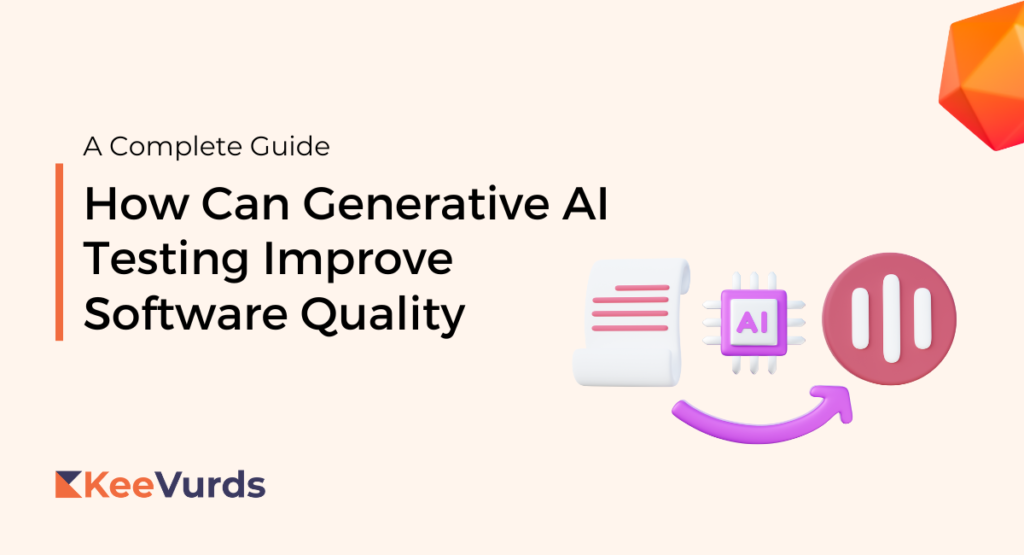Generative AI is rapidly becoming a game-changer in software testing, where its ability to learn from data enables it to generate comprehensive test cases.
Through AI-based test case generation, software quality can be enhanced by not only automating the testing process but also making it more thorough and efficient.
This innovative approach allows test cases to evolve alongside the software they are designed to check, ensuring the tests remain relevant and effective in catching bugs and issues that human test engineers might overlook.
The application of generative AI goes beyond routine automation by anticipating complex scenarios and stress conditions that software may encounter. It improves efficiency by rapidly generating a broad range of test cases, including edge cases, which are crucial for evaluating software quality and performance.
By integrating generative AI into the workflow, organizations can enjoy faster testing cycles with greater accuracy, leading to a more reliable software product.
Key Takeaways
- Generative AI enables the creation of more comprehensive and evolving test cases.
- It enhances test automation and efficiency, identifying potential issues before they escalate.
- A focus on generative AI in testing ensures higher quality and performance of the software.
Enhancing Test Automation with Generative AI
Generative AI is revolutionizing test automation by enabling more comprehensive test coverage and efficient test data generation. It leverages machine learning and natural language processing to automate intricate aspects of the testing process that were previously manual.
Improved Test Coverage and Case Generation
Generative AI applies deep learning algorithms to produce diverse test scenarios, including edge cases that might be missed by manual processes. Through AI-based test case generation, it can detect subtleties in the software that could translate into potential defects, which results in a broadened test coverage that ensures the software’s functionality and reliability are thoroughly evaluated.
- Test Scenarios: With generative AI, testers can increase the variety and number of test cases, covering more functionality and potential user interactions.
- Edge Cases: It specifically aids in identifying and creating tests for edge cases, ensuring that even the most unlikely scenarios are accounted for.
Streamlining Test Data Creation
Generative AI excels at creating robust and synthetic test data that mimics real-world conditions without the constraints and privacy issues of using actual customer data. It can generate and utilize large volumes of data quickly, improving the efficiency of the testing cycles.
Synthetic Data: Quality synthetic data helps in mimicking a variety of scenarios for testing, from typical user behavior to atypical system interactions.
Incorporating AI in Continuous Testing
The integration of generative AI into continuous testing frameworks ensures that every code change is automatically checked for potential issues. This continuous feedback loop enhances the overall quality of the software development lifecycle by detecting issues early and often.
- Testing Cycles: Generative AI keeps pace with rapid development cycles, providing immediate insights into the impact of code changes.
- Continuous Improvement: By consistently testing new code, generative AI tools help maintain software quality throughout its development.
Evaluating Software Quality and Performance
In the realm of software development, generative AI testing is becoming a critical tool for enhancing the quality and performance of software products. It brings a new level of effectiveness to quality assurance, enabling teams to detect and manage defects, assess security risks, and ensure the reliability and accuracy of software across various platforms, including mobile devices.
Detecting and Managing Defects
Generative AI greatly improves the effectiveness of defect detection. It can identify potential defects and performance bottlenecks that might elude traditional testing approaches. By analyzing large datasets and simulating user behavior, AI-driven tools can uncover subtle defects that might cause reliability issues down the line. They significantly reduce the occurrence of false positives and false negatives, making bug detection more accurate.
Assessing Security and User Experience
When it comes to security vulnerabilities, generative AI testing tools can simulate malicious attacks and unexpected user scenarios, enhancing the security testing processes. This approach ensures that software is not only functional but also secure, safeguarding against potential breaches.
In matters of user experience, AI testing can predict and evaluate real-world user interactions, ensuring that the software maintains a high performance on a variety of mobile devices and platforms.
Ensuring Reliability and Accuracy
Reliable software is software that consistently performs as expected. Generative AI aids in creating such stability by ensuring the accuracy of test results and continuously learning to improve testing scenarios. Scalability is also a pivotal advantage, where AI can simulate thousands of virtual users to test how well the software performs under stress, essential for assessing performance in a real-world environment.
This kind of testing is vital for quality assurance, contributing to the delivery of a robust and reliable software product.
Conclusion
Generative AI presents major advances in software testing, enhancing efficiency and test accuracy. By learning from historical data, it can predict and prevent potential defects, leading to more reliable and robust applications.
Its impact extends to all stages of the development cycle, optimizing test coverage and ensuring higher software quality. As the industry evolves, generative AI stands as a pivotal tool in the pursuit of excellence in software development.




